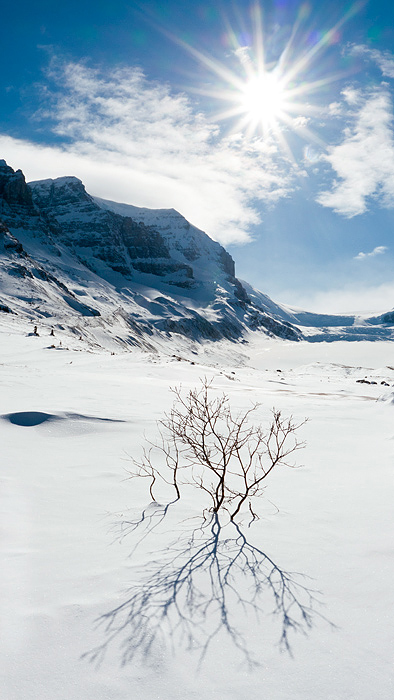As always, Alan Ernst, owner of the Aurum Lodge and co-leader on the winter tours has shown his skill at seeing fine images in scenes most of us would pass by. This time Alan gave himself a themed assignment and that self-assignment led to great images. Check out his images and learn about the art of photography from his descriptions below each photo.

©Alan Ernst
Mt Outram and snag – Lumix GH1, 14-45mm lens, F8 at 1/125, – 1/3 EV, Polariser, HDR
When going on a photo outing or even for a week, month or year, try to set yourself a subject “goal”. Having accompanied many winter tours in the past few years, I have lots of images of ice, frozen waterfalls, winter landscapes, etc.. This year I decided to concentrate on Winter Wood i.e. anything tree. Needless to say, I will still point my camera at everything else that looks promising. However, shooting a theme is fun and hones your visual skills, as you will be looking for stuff much more focused. Themes can be specific subjects, patterns, texture, numbers, letters, colours, etc., etc.

©Alan Ernst
Big Bend dead tree – Lumix G1, 100-300mm lens, F8 at 1/1000, +1 1/3 EV
I had photographed this impressive snag on half a dozen occasions before, usually trying to isolate it completely from its surroundings, which tend to be cluttered with little trees sticking out of the snow all over the place. This year, with ample snow cover in the mountains, much of the clutter was blanketed in snow and I decided to go for a landscape extraction instead. Revisiting locations is important as conditions are always different and the more often you go, the more your eye will pick up all the amazing details.

©Alan Ernst
Cold Burn – Lumix GH1, 7-14mm lens, f10 at 1/200, +1 EV
The remnants of a prescribed burn two years ago make for great images along the North Saskatchewan River valley, from charred bark to the relics of an entire forest. The group was photographing from the road as the snow was deep and cumbersome to get through. There were great repetitive patterns there but somehow, it felt like looking from the outside in, rather than being part of it – I decided to romp through the snow bank and immerse myself in the trees, which paid off as I got some pleasing shots in there. When shooting a location, always wander around and look for angles, viewpoints, subject detail other than what caught your eye initially.

©Alan Ernst
Lychen Lord – Lumix GH1, 14-45mm lens, f10 at 1/100, + 1 2/3 EV
Returning from a short walk to a frozen waterfall, I was waiting for one of our participants to catch up. Whereas some people get bored once they’re “done” and stop looking as they’re keen to move on, I always use “down time” to scan my surroundings, looking for details, patterns, flora, wildlife, etc.. Very often it is in these situations, that I find interesting subjects, which most of us including myself would simply walk past or over in their quest of capturing a particular thing or place. This broken spruce twig had fallen on the snow covered creek upside down and reminded me immediately of the living trees in Lord of the Rings.

©Alan Ernst
Shadow Blue – Lumix GH1, 7-14mm lens, f8 at 1/500, +1 EV
Shadows in general and tree shadows in particular make for great subjects, with or without the object that creates them. In this location, where most participants were working on the grand landscape, I was immediately drawn to the interesting patterns, lines and contrast of the tree shadows along the river shore, the trees in themselves being nothing special at all. The location and angle of the sun were tough though and it was impossible to use the shadow as a leading line towards some interesting feature. Thus, I focused on trying to balance the one big tree shadow with the multiple shadows of smaller trees and sandwich them between the shoreline and Mt. William Booth in the back.

©Alan Ernst
Power of the sun – Lumix GH1, 14-45mm lens, f22 at 1/250, + 2/3 EV, ND grad
The Columbia Icefields / Athabasca Glacier area never disappoints, very much so because of the atmospheric conditions which are often different from surrounding areas.
The light during our mid day stop was fairly harsh and I decided to work with the sun, rather than against it… The smallest aperture on your lens will generally give you the nice starbursts, when shooting directly into a pointed light source. More or less flare will always ensue, so make sure your lens is squeaky clean as every fleck of dust will increase that flare. Then, try to work flare so it becomes part of the composition. You cannot avoid it, but moving the camera a little bit, can often make the difference between a nasty flare, an interesting flare or minimal flare.

©Alan Ernst
Stump Morning – Lumix GH1, 14-45mm lens, f13 at 1/20, + 1 2/3 EV, Polariser and ND grad
Continuing the winter woods theme from the previous week, I decided to work this field of dead tree stumps along the shore, while the others were frolicking on the ice. The strong side lighting made for an extremely busy foreground with lots of rocks and snow drifts with amazing texture. They made for great abstracts and detail shots, but I could not find a good leading line towards the background that I was looking for. I thus decided to break all the rules and place the big stump smack in the center, so as to provide an anchor of sorts for the many components included in the image.

©Alan Ernst
Millitreed – Lumix G1, 100-300mm lens, f8 at 1/250, + 2/3 EV
The group stopped along the Icefields Parkway to capture the Spires of Mt Wilson drifting in and out of the clouds. I decided to look for landscape extractions on the slope of the mountain since the light wasn’t that good and I was drawn to the contrast between dark treed ledges everywhere along the mountain side. Most are horizontal bands of trees, but I liked this one best as it made for an interesting diagonal, flanked by two additional lines, which all seem to radiate from one corner.
One of the things I like about the Lumix cameras are the variable aspect ratios, which can be changed on the fly. The 16:9 format is my favourite, but I tend to switch all the time, depending on subject and composition. A lot of photographers seem to stick to the 3:2 or 4:3 formats provided by their camera sensors without putting too much thought into cropping at the point of capture. It is important though to think ahead and decide on the spot, if the image will look better cropped. Very often, this means you will have to change the angle a bit or include / exclude features that might interfere when cropping later. I find that I can often get two or three images of the same subject, which are very different, simply by changing the aspect ratio right then and there.

©Alan Ernst
One of Three – Lumix G1, 100-300mm lens, f9 at 1/800, + 1 1/3 EV
Returning from Jasper along the Icefields Parkway, a stand of trees along the side of the road caught my eye because of the straight tree trunks and the angled shadows, which created a repetitive pattern. Check rear view mirror, stop, reverse and see what we can make of it. There were lots of young trees in front of the embankment as well as little trees and shrubs within the trees so it was hard to “extract” what I wanted. Pacing back and forth and zooming in with a long lens eventually got me a few images free of distractions with minimal subject matter but a pleasing effect. Working a subject, it is important to decide on what is important / makes it interesting and then either putting that into context with its surroundings OR extracting it for a strong graphic effect. You will need minimal gear for this: two eyes, two legs, a tele zoom and a brain, which can co-ordinate it all….

©Alan Ernst
Hang in there – Lumix G1, 100-300mm lens, f 9 at 1/800, +1 EV
Waiting by the car for the rest of the group to tackle the snow humps at Medicine Lake I was scanning the slopes of the Colin Range, which usually makes a great backdrop at sunset. In this case however, it was mid day and relatively flat front lighting, so the big picture was out. Small groups of trees clinging to life at tree line were interesting as they provided a strong contrast to an otherwise medium toned puzzle of rock slabs and snow.
For images like this, it is critical to use your tripod even when you have more than enough shutter speed to work without. Concentrating on your key subject (small stand of trees) and then zooming in and out, panning up and down, left and right, until you find a pleasing composition takes time and, especially when working with a long lens, you will never get the composition where you want it to be. Live view is a great help as what you see is what you get. In this case, there were distracting dark areas or lines, more trees, rock formations which would have been very distracting if included. It probably took all of ten minutes to get a composition which excluded it all and which I liked. The rule of thirds was dumped along the way.

©Alan Ernst
Dead Pine – Lumix G1, 100-300mm lens, f 11 at 1/250, + 1 1/3 EV
And more dead trees… A single dead tree surrounded by living specimens will always stick out and once it attracts attention, there is likely something to photograph. This one caught my eye as I was looking for the sun to see if we would get some clouds for another scene I had in mind. The cloud wasn’t forthcoming but the strong graphic component, extreme contrast and almost monochrome aspect of the scene, made me go for the long tele lens again and pace back and forth until I had it lined up with the mountain behind it. I then played with the aperture to find a setting, which provided enough detail in the background to make it identifiable, but not so much where it would compete with the silhouette in front.

©Alan Ernst
Shadow Dancers – Lumix G1, 100-300mm lens, f9 at 1/1000, + 1 EV
Half the group was waiting for the other half at an outhouse stop near the Crossing. When they did not show up, we decided to backtrack to the N. Saskatchewan River Bridge, where I had noticed potential for a high contrast river scene with a hazy mountain backdrop. The big scene worked, but as I scanned the riverbank for detail, the picture perfect S-curve of a snowdrift caught my attention. Back to the vehicle for the long lens and then try to find an arrangement that worked. Normally, this would call for a vertical orientation, but alas there were too many distractions of trees, rocks, and dirty snow both above and below the scene. I took the scene with 4:3, 3:2 and 16:9 aspect ratio and interestingly, the least likely format (i.e. the furthest from the vertical), worked the best.







































